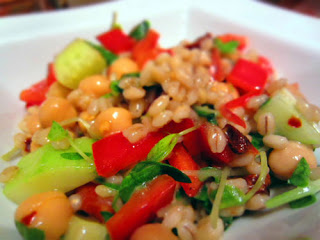Image © Monika Wisniewska - Fotolia.com
Are you like me and love yoga but have never made it to any of the Yoga Journal Conferences? I've been wanted to go to one for years. Luckily for use they post several of the Audio Recordings online. And I thought many of you might be interested in one I found on The Yoga of Food. It's really inspiring to eat well and interesting how they discuss practicing yoga and having a relationship with your food are both always evolving and changing.
Dayna Macy, author of Ravenous, moderates the panel discussion with Cyndi Lee who wrote Yoga Body, Buddha Mind, Steve Nakon, Seane Corn, and Aadil Paklhivala, author of Fire of Love.
The panel discussed various topics around how yoga effects our eating and healthy eating in general. One point made is that yoga helps us become more conscious of our bodies and get in touch with our breath. As this happens our tastes change. We become more aware of what we are eating and make better choices. And over time, just like our relationships change, our diet changes as well. A good diet is a practice just like all other practices, including diet.
It is proposed that when deciding what is the best way to eat, think "simple and elegant" and don't make things too complicated. Keep things in line with what feels good for you and don't make any judgments.
Advertising by the food companies aimed at both children and adults is also discussed. We often get seduced by marketing of agribusiness and start thinking certain things are healthy or unhealthy for us. But we are an over-weight nation full of sickness and fatigue. Pay attention to the energy food gives you. When you eat something does it make you tired and lazy? Does it give you energy?
Four things to eliminate from our diet as quickly caffeine, alcohol, tobacco, and refined sugar. Artificial chemicals must be avoided by everyone. There is nobody who can benefit by ingesting artificial chemicals and toxins into their body. So a good shift to work towards is to go organic. When you dine out, ask what is organic on the menu (even if you know there is nothing organic) because that helps breed awareness among the restaurants.
Pay attention when you are eating because many time we over eat simply because we are not paying attention. This is a culture that eats the most and is also the most under-nourished. Our stomachs are meant to be incredibly acidic for easy digestion but most people's stomach acid is way too low. Stress and chemicals both destroy your body's ability to produce acid. Eating as close to nature as possible is the best way to eat. And it is also important to "eat with happiness" because it's all about the joy of food.
One of the themes that comes up over and over is to not feel guilty or fearful when making your food choices. Try to be smart and stick with it.
Listen to the 2011 Yoga Journal Conference Midwest Panel Discussion: "The Yoga of Food" with Seane Corn, Cyndi Lee, Steve Nakon and Aadil Palkhivala. Moderated by Dayna Macy.
You can view all of the audio recordings here.
Love is all around you...
- Rachel
Twitter: @RachelRubin
Connect with me on Facebook
Visit me on Google+
Network on LinkedIn
Watch me (or my pets) on YouTube
Eat with me on Yelp








